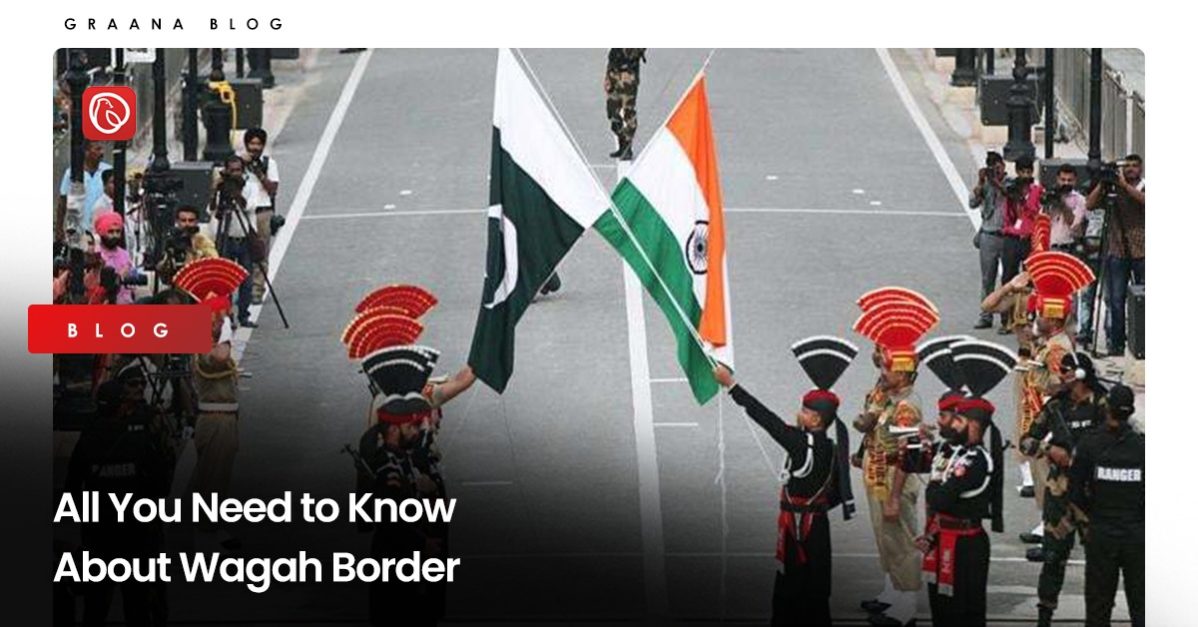
The Wagah Border is the border crossing between India and Pakistan, located near the city of Lahore in Punjab. It is famous for its daily ceremony, which is a display of military parade, dance, and music by soldiers from both countries. This ceremony makes it a popular tourist attraction, drawing hundreds of visitors every day.
Graana.com gives an overview of the Wagah Border below, including its history, retreat ceremony, railway station and flag.
The Wagah Border was established during the partition of Pakistan from India, marking the boundary between the two countries. It was carefully planned and positioned with increased security measures, including the creation of a complex map. It is located 600 metres east of Wagah village.
Wagah Border is strategically located on the Grand Trunk Road, about 24 kilometres from Lahore and 32 kilometres from Amritsar, India. Additionally, it is only 3 kilometres from Attari village in India, which is why the ceremony that takes place at the border is known as the Wagah-Attari border ceremony.
It can be too hot during the summer to visit the Wagah border. This is why paying a visit during the winter months is recommended, preferably in January, February, or March. The pleasant weather will allow visitors to enjoy watching the border ceremony.
In short, if you are visiting Lahore and want to explore historical places in Lahore and its neighboring areas, you should visit the Wagah border.
| Day | Wagah Border Timings |
|---|---|
| Summer (April to September) | 5:15 PM |
| Winter (October to March) | 4:15 PM |
The Beating Retreat Ceremony, also called the Wagah-Attari Border Ceremony, is held daily and draws large crowds of enthusiastic spectators, particularly on weekdays when attendance can exceed 2000 people.
It involves a simultaneous raising and lowering of flags, often preceded by a cultural dance performance. The Border Security Force entirely manages the event on the Indian side and the Rangers on the Pakistan side.
The ceremony symbolises both the rivalry and the brotherhood between the two nations. Military personnel from each side simultaneously lower their country’s flag and exchange handshakes, displaying a remarkable level of discipline throughout the event.
The Beating Retreat Ceremony serves as a poignant reminder that despite the tension and animosity between the two nations, India and Pakistan share a rich history and culture.
The Wagah railway station, operated by Pakistan Railways, is situated in Wagah and is the final station on the Lahore-Wagah Branch Line. It functions as a border station for individuals crossing into India and also facilitates immigration and customs clearance for passengers travelling on the Samjhauta Express between India and Pakistan.
In August 2017, India constructed a monumental 360 ft (110m) flagpole on its side of the border in Attari, Punjab. This flagpole stands as the tallest in India and has become a popular tourist attraction in the region. In response, Pakistan installed a 400 ft (122m) flagpole on its side of the border, in Wagah.
It is the largest in the country and serves as a symbol of national unity and patriotism. The flagpole has become a popular site for tourists and is often illuminated at night.
Both these flagpoles have added to the rivalry and competitiveness between the neighbouring nations. However, they also serve as a testament to the deep sense of national pride that exists in both India and Pakistan.
A: The Wagah Border is the border between India and Pakistan, near the cities of Amritsar in India and Lahore in Pakistan.
A: The Wagah Border is a symbol of the long-standing and often tumultuous relationship between India and Pakistan. It is also the only border crossing between the two countries that is regularly open for civilian use.
A: The daily ceremony at the Wagah Border is a military drill and flag-lowering ceremony that is performed by both the Indian BSF and the Pakistan Rangers. It is a highly choreographed event that is meant to symbolise the end of the day and the lowering of national flags.
A: The ceremony takes place every day at sunset, which varies depending on the time of year. During winter, the ceremony starts at around 4:30 pm and around 5:30 pm during the summer.
A: There is no strict dress code for attending the ceremony. Though, it is recommended to dress modestly and in comfortable clothing, as the ceremony can be quite crowded and could last for around an hour.
A: The ceremony at the Wagah Border lasts for around 45 minutes to an hour.
A: Yes, foreigners are welcome to attend the ceremony at the border. However, it is recommended to bring proof of identification.
A: Photography and videography are allowed during the ceremony. However, it is important to follow the guidelines set by security personnel and avoid obstructing the view of others.
For more related information, visit Graana Blog.
Thakot, which is surrounded by the ever-gorgeous scenery of Pakistan, is a small town that…
The exciting combination of the accuracy of aerospace manufacture and the thrill of military aviation…
With the arrival of Pakistan's summer, the intense heat makes it imperative that you find…
Choosing the right healthcare facility ensures the best medical outcomes and overall well-being. For residents…
Shangla is among the top districts in northern Pakistan that need to be explored. It…
.Lakki Marwat is one of the fastest-growing cities in KPK. Tribal areas, now included in…